I. Introduction
Palm trees are a diverse group of plants known for their iconic appearance and association with tropical and subtropical regions. They belong to the family Arecaceae and are characterized by their tall, slender trunks and large, fan-shaped or feather-like leaves called fronds. Palm trees have been revered for centuries for their beauty, resilience, and practical uses.
A. Importance of palm trees in landscaping and tropical regions

Palm trees hold immense importance in landscaping and tropical regions. They provide aesthetic appeal, create tropical ambiance, offer shade, control erosion, support biodiversity, provide environmental benefits, and possess economic value. Their presence enhances the beauty of landscapes, adds to the allure of tropical destinations, and contributes to sustainable ecosystems.
B. Purpose of the guide: Helping beginners identify and care for palm tree species

Helping beginners identify and care for palm tree species is crucial for providing appropriate care, ensuring optimal growth, and maintaining the health of these magnificent trees. Accurate species identification allows beginners to tailor their care practices, understand growth patterns, adapt to local conditions, follow specific care guidelines, and select trees that align with their preferences. With the right knowledge and guidance, beginners can embark on a fulfilling journey of successfully cultivating and nurturing palm trees.
II. Understanding Palm Trees
A. Basic characteristics of palm trees
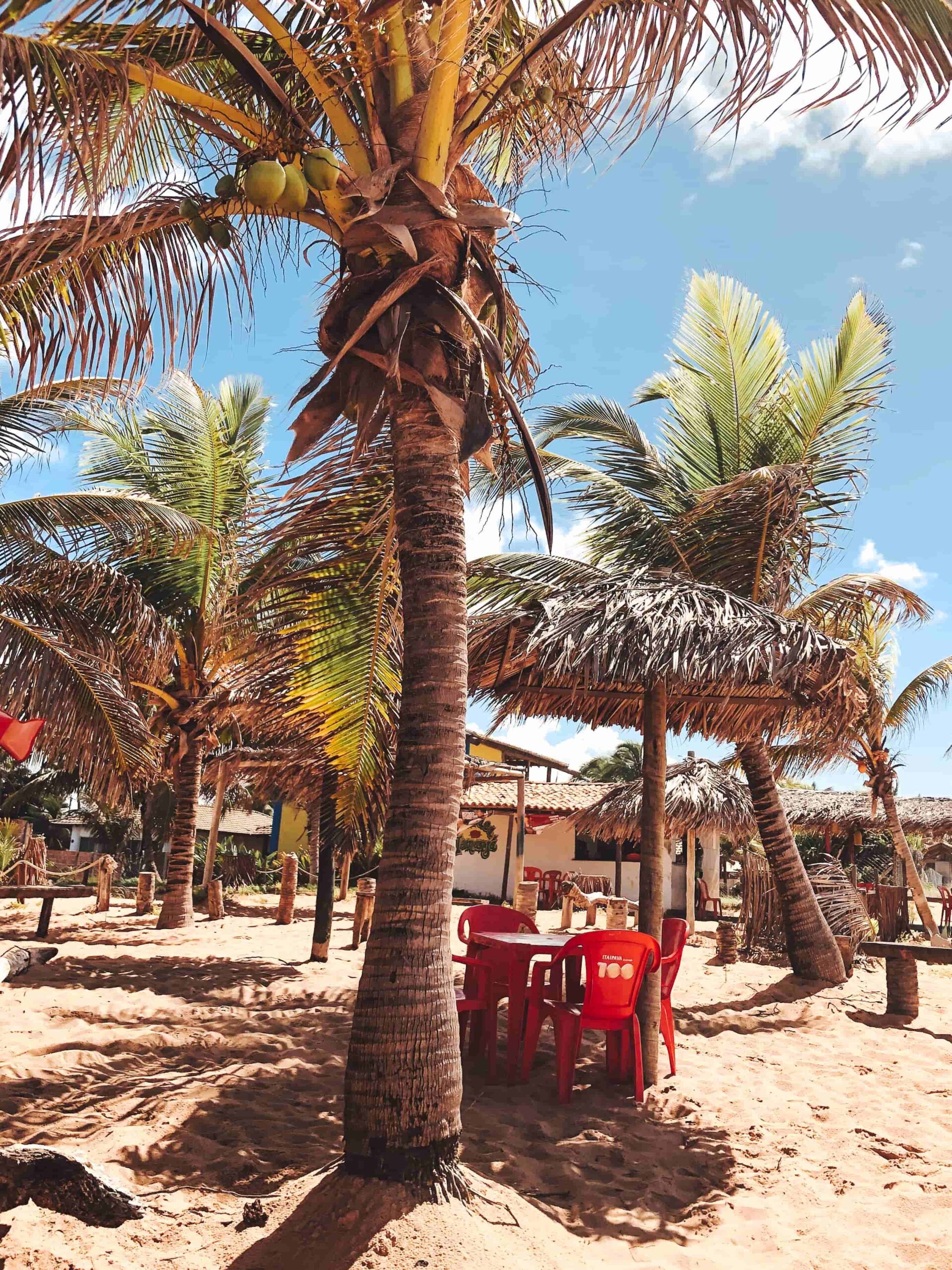
- Leaves: Palm trees have large, compound leaves called fronds. The fronds are usually long and fan-shaped or feather-like in appearance. They can range in size from a few feet to several meters long, depending on the species.
- Trunk: Palm tree trunks are typically tall and slender. They are often smooth, although some species may have trunk textures created by the retained bases of old leaves. The thickness of the trunk can vary depending on the species and age of the tree.
- Root System: Palm trees have extensive root systems that help anchor them in the ground. The roots also serve to absorb water and nutrients from the soil. Palms are known to have both deep roots that penetrate the ground and surface roots that spread horizontally.
- Evergreen Nature: Palm trees are typically evergreen, meaning they retain their leaves throughout the year. While individual fronds may die and be shed, new fronds continuously grow from the top of the tree, maintaining its green appearance.
- Adaptability: Palm trees are highly adaptable and can be found in various environments worldwide. They are commonly associated with tropical and subtropical regions but can also thrive in desert areas. Palms have evolved to withstand strong winds, high temperatures, and limited water availability.
- Cultural Significance: Palm trees have cultural and symbolic importance in many societies. They are often associated with relaxation, tropical landscapes, and beachfront locations. Palms are also economically valuable, providing resources such as coconuts, palm oil, and palm fronds for various purposes.
B. Benefits of growing palm trees

- Aesthetic appeal: Palm trees are known for their striking appearance, adding beauty and visual interest to landscapes. They create a tropical or exotic ambiance, making them popular choices for gardens, parks, and resorts.
- Shade and cooling: Tall palm trees provide shade, helping to reduce the intensity of sunlight and heat in their vicinity. This can create a cooler microclimate, making them valuable for providing shade in outdoor spaces such as parks, patios, and seating areas.
- Erosion control: Palm trees play a role in preventing soil erosion. Their extensive root systems help bind the soil together, stabilizing slopes and reducing the risk of erosion caused by wind or water.
- Windbreak and noise reduction: Palm trees can act as natural windbreaks, helping to shield areas from strong winds. Additionally, their dense foliage can help absorb and reduce noise levels, making them beneficial for noise pollution mitigation.
- Carbon sequestration: Like other trees, palm trees absorb carbon dioxide (a greenhouse gas) during photosynthesis and store carbon in their trunks and leaves. By growing palm trees, you contribute to carbon sequestration, helping to mitigate climate change.
- Economic value: Certain palm species have economic significance. For example, coconut palms provide coconuts, which are used for food, oil, fiber, and other products. Oil palm trees are cultivated for palm oil, a versatile and widely used vegetable oil. These palm products can have economic benefits for local communities and industries.
- Habitat for wildlife: Birds, insects, and other animals are attracted to palm trees, contributing to biodiversity and ecosystem health.
- Cultural and historical significance: Palm trees often hold cultural and historical importance in many regions. They may have symbolic value, represent cultural heritage, or be used in traditional ceremonies and practices.
III. Identifying Different Palm Tree Species

A. Popular palm tree species for beginners
1. Areca Palm Tree (Dypsis lutescens)
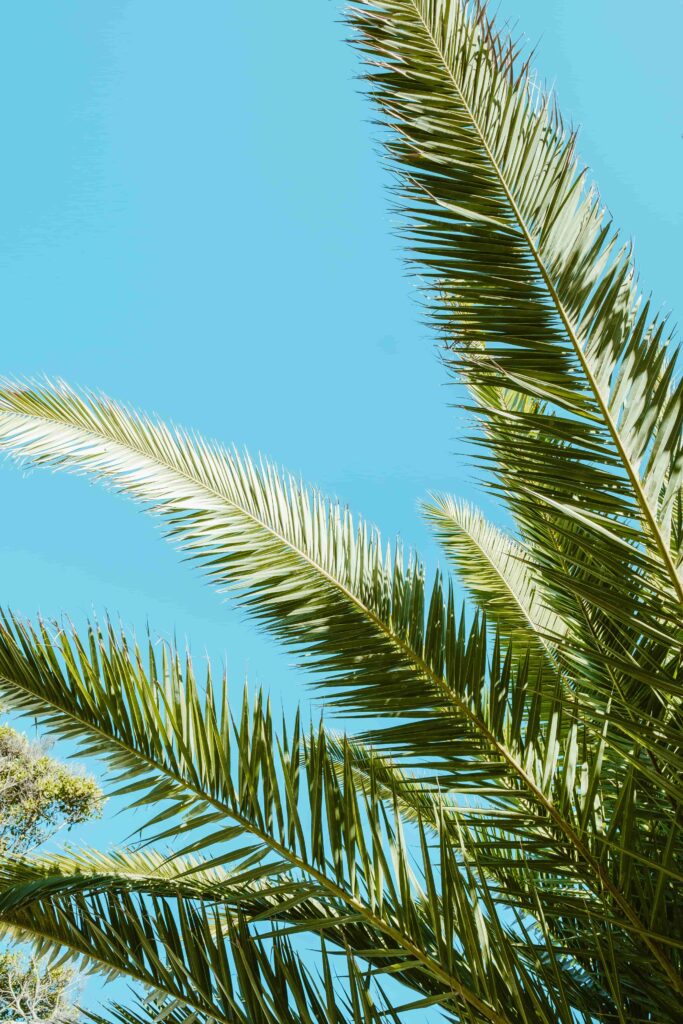
The Areca Palm’s attractive foliage, slender trunk, and graceful arching leaves make it a popular choice for indoor landscaping, providing a touch of tropical elegance to homes, offices, and other interior spaces.
a. Description of physical features
- Height: The Areca Palm plant grows from a single trunk. Reaches a height of 6 to 20 feet (1.8 to 6 meters) with proper care and conditions.
- Leaves: The Areca Palm leaves emerge from the top of the trunk in an arching manner. The leaves are long and narrow, measuring around 4 to 8 feet (1.2 to 2.4 meters) in length. Multiple pairs of leaflets arranged in a symmetrical pattern along the central axis called the rachis.
- Leaflets: The foliage of the Areca Palm is a vibrant, glossy green color, which adds a lush and tropical feel to any setting. The leaflets have a slightly curved shape and a pointed tip, enhancing the elegant appearance of the palm.
- Trunk: The trunk of the Areca Palm is smooth, slender, and light green or yellowish-green in color. As the palm matures, the trunk develops prominent rings caused by the scars of shed leaves, creating a textured pattern. However, when grown indoors, the trunk is usually not as evident due to the young age of the plant.
- Clumping Habit: In its natural habitat, the Areca Palm often forms clusters or clumps of multiple stems arising from a common base. This gives it a dense and full appearance. However, when grown as a houseplant, it typically consists of a single trunk, unless multiple palms are intentionally planted together for decorative purposes.
- Flowers and Fruits: When provided with the right conditions, mature Areca Palms may produce small, yellowish flowers clustered on branched inflorescences. Female flowers give rise to small, round, and reddish-orange fruits. However, it is rare for these indoor palms to flower and produce viable fruit.
b. Unique characteristics and growth habits
- Clumping Growth: One of the unique characteristics of the Areca Palm is its natural tendency to grow in clusters or clumps. In its native habitat, multiple stems arise from a common base, creating a dense and full appearance.
- Fast Growth Rate: The Areca Palm is known for its relatively fast growth rate compared to many other palm species. Under optimal conditions, it can grow several feet in a single year.
- Arching and Feather-Like Leaves: The Areca Palm features arching leaves that give it a graceful and elegant appearance. The fronds are pinnate, meaning they consist of multiple pairs of leaflets arranged along a central rachis. The leaflets are long, narrow, and have a feather-like structure, creating a delicate and tropical foliage display.
- Low Light Tolerance: Compared to many other palm species, the Areca Palm has relatively good tolerance to lower light conditions.
- Moderate Watering Needs: The Areca Palm has moderate watering requirements. It prefers slightly moist soil but can tolerate short periods of drought.
- Indoor Adaptability: The Areca Palm is a popular choice for indoor cultivation due to its manageable size, attractive foliage, and ability to tolerate indoor conditions.
c. Preferred growing conditions
- Temperature: Areca Palms prefer temperatures between 65°F (18°C) and 75°F (24°C). They are sensitive to cold drafts and temperatures below 55°F (13°C), so it’s essential to keep them away from cold windows or air conditioning vents.
- Light: These palms enjoy bright, indirect light. They can tolerate some direct sunlight during the morning or late afternoon, but intense sunlight can scorch their leaves. Place the palm near a window with filtered light or provide it with dappled shade outdoors.
- Watering: The Areca Palm appreciates consistent moisture but doesn’t like to sit in waterlogged soil. Water the palm thoroughly when the top inch (2.5 cm) of the soil feels dry, allowing excess water to drain away. Avoid overwatering or letting the plant dry out completely, as both can harm the palm.
- Humidity: Being native to tropical regions, Areca Palms thrive in high humidity. Mist the foliage regularly to increase humidity around the plant, especially during dry periods or when placed in air-conditioned environments. You can also place the palm on a tray filled with water and pebbles to create a humid microclimate.
- Soil: Well-draining soil is crucial for the Areca Palm. A mix of peat moss, perlite, and sand works well. Avoid heavy soils that retain water.
- Fertilizer: Feed the Areca Palm with a balanced, water-soluble fertilizer formulated for palm trees. Apply the fertilizer every two to three months during the growing season (spring and summer) to promote healthy growth. Follow the manufacturer’s instructions for the appropriate dosage.
- Pruning: Remove any yellow or brown leaves regularly to maintain the palm’s aesthetic appeal and prevent the spread of diseases. Trim back any damaged or dead fronds with clean pruning shears. It’s important not to remove too many healthy fronds as they are vital for the plant’s overall health.
2. Queen Palm Tree (Syagrus romanzoffiana)
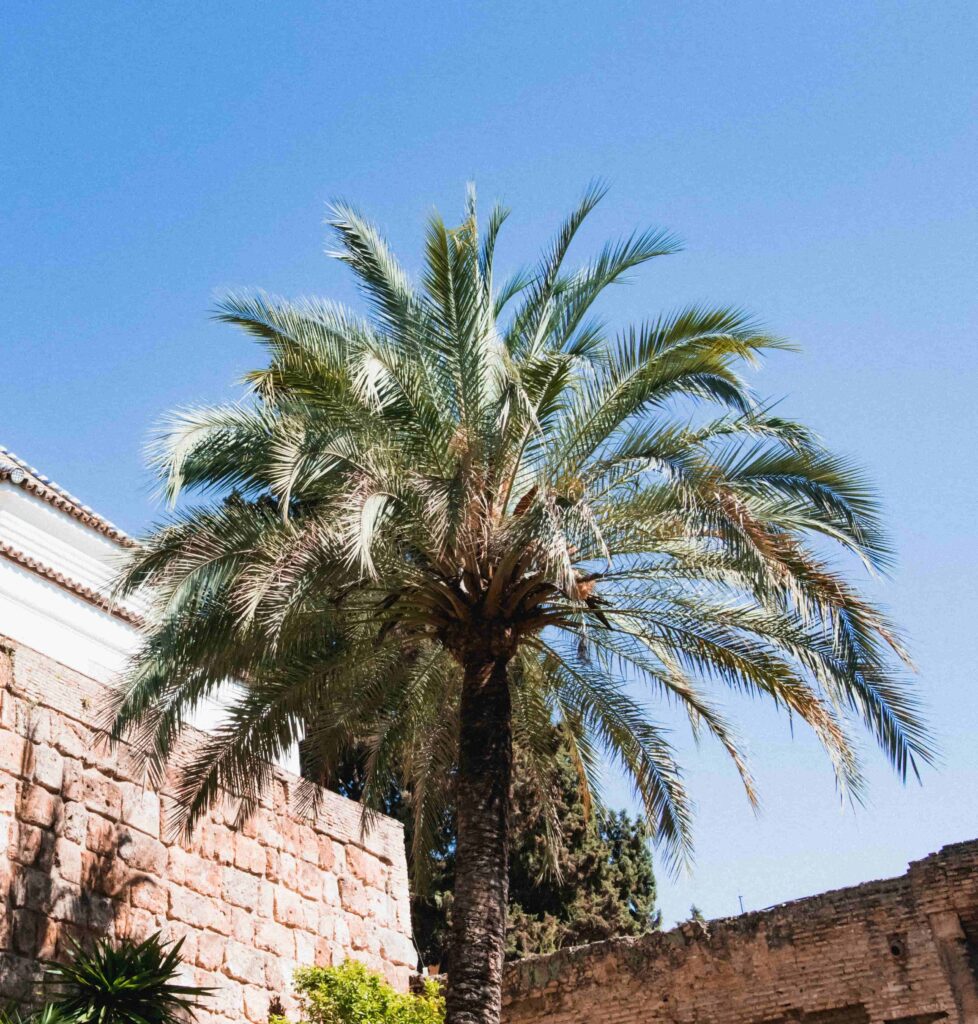
The Queen Palm Tree, scientifically known as Syagrus romanzoffiana, is a majestic and graceful palm species that is native to South America. It is widely recognized for its impressive physical features, making it a popular choice for landscaping and ornamental purposes in various tropical and subtropical regions around the world.
a. Description of physical features
- Height: Queen Palm Trees are known for their impressive height, reaching an average of 50 to 70 feet (15 to 21 meters) tall. Some exceptionally tall specimens can even exceed these measurements.
- Leaves: The leaves of the Queen Palm are pinnate, meaning they are feather-like and composed of multiple leaflets. The fronds emerge from a central point at the top of the tree and arch gracefully downward. Each frond can measure between 8 to 15 feet (2.4 to 4.6 meters) in length.
- Leaflets: The leaflets of the Queen Palm are long and narrow, 2 to 3 feet (0.6 to 0.9 meters) in length. They have a dark green color and a slightly drooping appearance, adding to the tree’s elegant aesthetic.
- Trunk: The trunk of the Queen Palm is slender and straight, characterized by a smooth, gray-brown bark. It has distinct rings, which are remnants of old leaf scars.
- Flowers: The Queen Palm produces small, creamy white flowers that grow in large clusters, known as inflorescences. These flowers are fragrant and attract various pollinators, such as bees and butterflies.
- Fruits: Following pollination, the Queen Palm produces small oval-shaped fruits that transition from green to orange-yellow when ripe. These fruits, often referred to as “dates” or “palm berries,” contain a single seed surrounded by a sweet, edible pulp.
- Root System: Queen Palms have a fibrous root system that spreads out horizontally rather than growing deep into the ground. This characteristic makes them susceptible to being uprooted in strong winds or unstable soil conditions.
- Crown: The canopy of a Queen Palm is expansive and symmetrical, composed of gracefully arching fronds that create a lush and tropical appearance. The overall shape of the crown is full and round, adding to the tree’s regal beauty.
b. Unique characteristics and growth habits
- Feather-Like Fronds: One of the distinct features of the Queen Palm Tree is its feather-like fronds. The long, arching fronds have a graceful appearance and are composed of multiple pinnate leaflets. This gives the tree a distinctive tropical look.
- Self-Cleaning Trunk: The trunk of the Queen Palm Tree has a unique self-cleaning characteristic. As the older fronds age and die, they detach from the trunk on their own, leaving a clean and smooth appearance. This eliminates the need for manual pruning or removal of dead fronds.
- Rapid Growth: Queen Palm Trees are known for their fast growth rate. With proper care and ideal conditions, they can grow several feet per year, reaching their mature height relatively quickly compared to other palm species.
- Tall and Towering: Mature Queen Palm Trees can grow to impressive heights, often reaching 50-70 feet (15-21 meters) tall. This vertical growth habit adds a majestic and dramatic element to the landscape.
- Clustered Flowering: The Queen Palm Tree produces unique flowering clusters known as inflorescences. These clusters emerge from among the fronds and contain numerous small flowers. The flowers are creamy-white in color and have a pleasant fragrance, attracting pollinators like bees and butterflies.
- Abundant Fruit Production: After the flowers are pollinated, the Queen Palm Tree produces clusters of small, round fruits. These fruits are typically orange-red in color and about 1 inch (2.5 centimeters) in diameter.
- Drought Tolerance: Despite their tropical appearance, Queen Palm Trees have a moderate level of drought tolerance. Once established, they can withstand periods of reduced rainfall or dry conditions. However, regular watering is still necessary for optimal growth and to maintain their overall health.
- Wind Resistant: Another unique characteristic of the Queen Palm Tree is its ability to withstand wind and storms. The flexible trunk and the feathery fronds allow the tree to sway with the wind, reducing the risk of damage or uprooting during strong gusts.
- Ornamental Value: The Queen Palm Tree is widely used as an ornamental plant in landscaping. It adds an elegant touch to gardens, parks, and urban areas, enhancing the overall aesthetic appeal.
c. Preferred growing conditions
- Climate: Queen Palm Trees thrive in tropical and subtropical climates. They prefer areas with warm temperatures and are sensitive to cold weather. Frost and freezing temperatures can cause damage to the tree.
- Sunlight: These palm trees prefer full sun exposure. They require at least 6 hours of sunlight in a day to flourish. Insufficient sunlight may lead to weak growth and poor frond development.
- Soil: Well-draining soil is crucial for Queen Palm Trees. They prefer loamy soil that retains some moisture while allowing excess water to drain away. Avoid heavy clay soils that tend to retain water, as it can lead to root rot.
- Watering: Queen Palm Trees require regular and moderate watering. They have moderate drought tolerance but thrive when provided with consistent moisture. Water deeply, thoroughly and avoid over watering.
- Humidity: These palm trees prefer moderate to high humidity levels. Adequate humidity helps maintain the health and vigor of the tree, especially in drier climates. If you live in an arid region, consider using a humidifier or misting the fronds occasionally to increase humidity levels.
- Fertilizer: Queen Palm Trees benefit from regular fertilization. Apply a balanced slow-release palm fertilizer, preferably one rich in micronutrients, during the growing season. Follow the manufacturer’s instructions for application.
- Pruning: Minimal pruning is required for Queen Palm Trees. Trim back any damaged or dead fronds to maintain the palm’s aesthetic appeal. However, avoid excessive pruning, as it can stress the tree and inhibit its growth.
- Wind: Queen Palm Trees can tolerate moderate winds, but strong, gusty winds can damage their fronds. If you live in a windy area, consider planting the tree in a sheltered location or providing temporary wind protection until it establishes a stronger root system.
- Mulching: Applying a layer of organic mulch around the base of the tree helps conserve moisture, regulate soil temperature, and suppress weed growth. Use mulch such as wood chips or shredded bark, but ensure it does not touch the trunk to prevent rot.
3. Fan Palm Tree (Livistona australis)
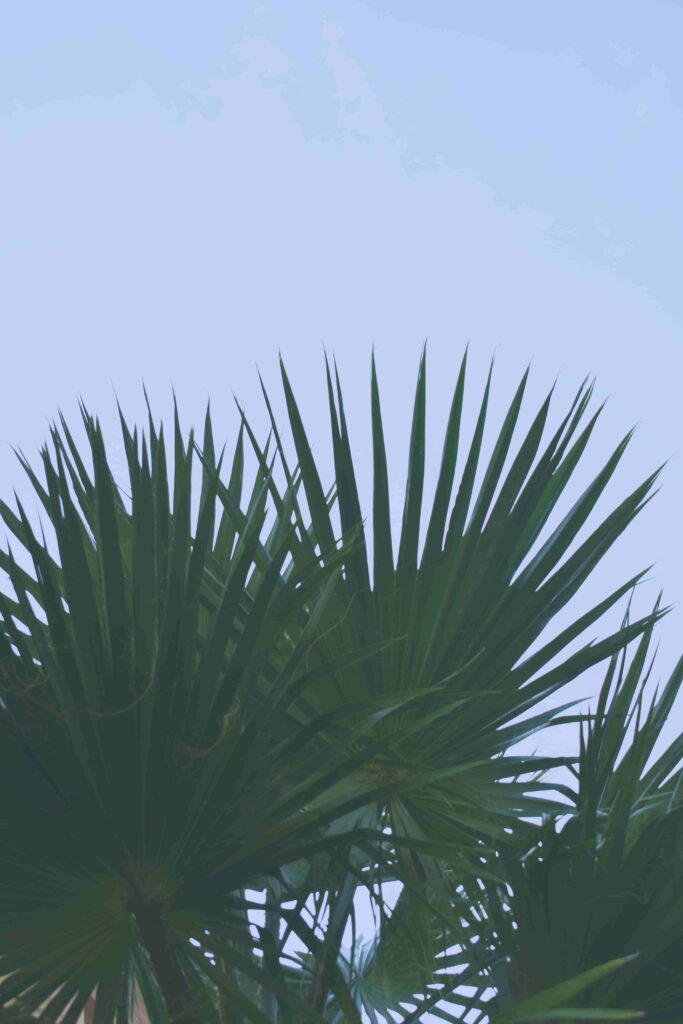
The Fan Palm Tree, scientifically known as Livistona australis stands out with its slender trunk, large fan-shaped leaves, dense crown, and subtle flowers and fruits. Its distinct physical features make it an attractive and captivating addition to landscapes and gardens.
a. Description of physical features
- Trunk: The trunk of the Fan Palm Tree is slender, straight, and can grow to a considerable height. It is covered in fibrous and textured persistent leaf bases, which give it a rough and distinctive appearance. The trunk’s color can vary from pale gray to light brown, adding to its visual appeal.
- Leaves: The most striking feature of the Fan Palm Tree is its large, fan-shaped leaves. These leaves are deeply divided into segments that radiate outwards, resembling an open fan. The individual leaf segments are elongated and taper towards the tip, creating an elegant and symmetrical arrangement. The leaves are typically a vibrant, glossy green color, adding a lush and tropical element to the tree’s overall aesthetic.
- Crown: The Fan Palm Tree forms a dense crown of leaves at the top of its trunk. This crown can span several meters in diameter and provides ample shade and shelter. The arrangement of the leaves in the crown gives the tree a full and lush appearance, enhancing its visual appeal.
- Flowers: The Fan Palm Tree produces small, inconspicuous flowers. These flowers are typically pale cream or yellowish in color and may not be particularly showy. They form in clusters on long, drooping stalks that emerge from within the leaf crown.
- Fruits: Following the flowers, the Fan Palm Tree produces small, round fruits. The fruits start off green and gradually turn black as they ripen. While not a prominent feature, these fruits add an additional element of interest to the tree’s appearance.
b. Unique characteristics and growth habits
- Tolerant of Different Environments: The Fan Palm Tree have ability to adapt to various environmental conditions. It can thrive in coastal regions, rainforests, and even inland areas. This adaptability makes it a versatile choice for landscaping projects in diverse climates.
- Drought Tolerance: One of the notable features of the Fan Palm Tree is its resilience to drought conditions. It has developed mechanisms to conserve water and withstand periods of low rainfall. This characteristic makes it an excellent choice for gardens or landscapes in arid or semi-arid regions.
- Slow Growth Rate: The Fan Palm Tree takes its time to establish and grow, resulting in a sturdy and long-lasting tree. This slow growth habit contributes to the tree’s overall strength and endurance.
- Longevity: With proper care and maintenance, it can live for several decades, providing beauty and shade for an extended period.
- Self-Cleaning: The Fan Palm Tree has a unique self-cleaning mechanism. As the older leaves age and become brown or yellow, they detach from the tree and fall off naturally. This self-pruning characteristic eliminates the need for manual leaf removal, reducing maintenance efforts.
- Attractive Bark: As the Fan Palm Tree matures, the bark on its trunk develops a unique texture and appearance. It becomes rough and fibrous, creating an interesting visual contrast against the smooth, green leaves. This textured bark adds to the tree’s overall aesthetic appeal.
- Clustering Habit: In its natural habitat, the Fan Palm Tree often grows in clusters or small groups, rather than as solitary individuals. This clustering habit creates a visually appealing and cohesive effect, especially when multiple trees are planted together in a landscape design.
- Wildlife Habitat: The Fan Palm Tree provides a valuable habitat for various wildlife species. Its dense crown of leaves offers shelter and nesting sites for birds and small animals. The tree’s flowers and fruits also attract pollinators and seed-dispersing animals, contributing to the local ecosystem.
c. Preferred growing conditions
- Climate: The Fan Palm Tree thrives in a subtropical to temperate climate. It prefers regions with mild winters and warm summers. It is well-suited to coastal areas and can tolerate salt spray, making it an excellent choice for seaside gardens.
- Sunlight: This palm species prefers bright, indirect sunlight. It thrives in partially shaded areas where it receives filtered light or morning sun. While it can tolerate full sun, providing some shade during the hottest parts of the day can help prevent leaf scorching.
- Soil: Well-drained soil is crucial for the Fan Palm Tree’s health. It prefers moist but not waterlogged soil. Sandy loam or sandy soils with good drainage are ideal.
- Watering: The Fan Palm Tree has moderate water requirements. It is important to keep the soil evenly moist during the growing season, but avoid overwatering.
- Fertilization: Providing appropriate nutrients is important for the Fan Palm Tree’s growth. Use a slow-release palm fertilizer or a balanced granular fertilizer specifically formulated for palm trees. Follow the manufacturer’s instructions for application, typically in spring and summer, to promote healthy growth.
- Pruning: The Fan Palm Tree typically does not require extensive pruning. Remove any dead or yellowing fronds as needed to maintain a tidy appearance. Avoid excessive pruning, as it can harm the tree and inhibit its growth.
- Protection from Frost: While the Fan Palm Tree is relatively tolerant of mild frosts, it is advisable to protect young and newly planted specimens from freezing temperatures. Covering the tree with frost cloth or providing temporary shelter can help prevent cold damage.
- Wind Protection: The Fan Palm Tree benefits from some wind protection, especially in regions with strong, gusty winds. Planting it near structures, fences, or windbreaks can shield it from excessive wind exposure.
B. Additional palm tree species for further exploration
1. Date Palm Tree (Phoenix dactylifera)
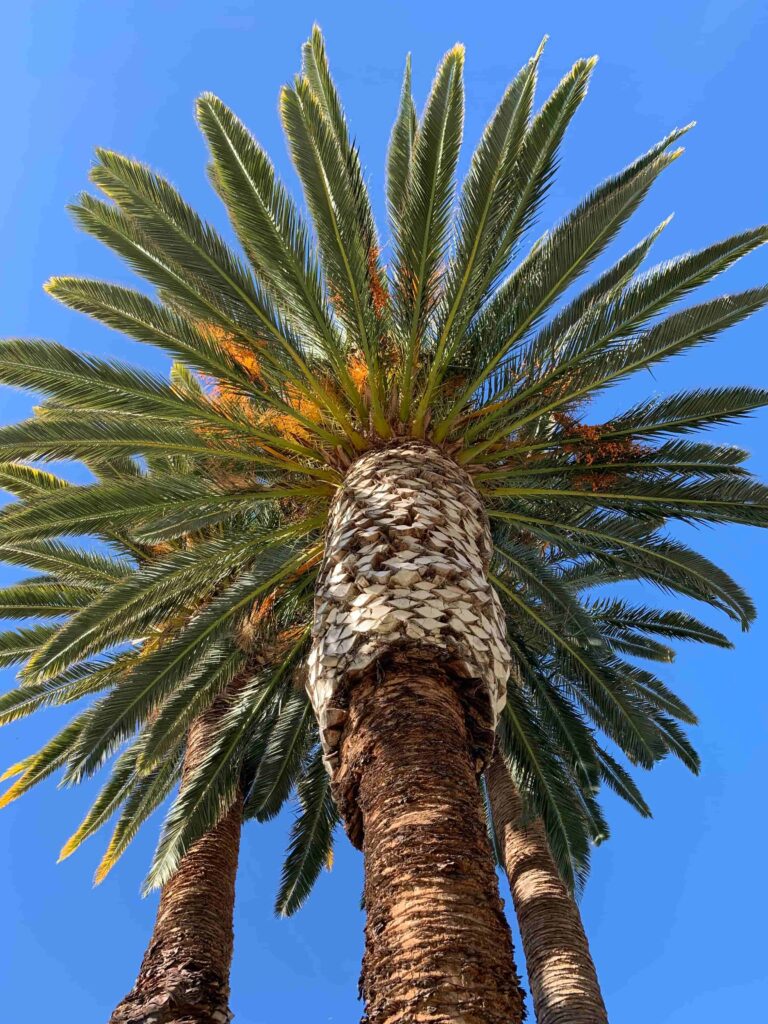
The Date Palm Tree, scientifically known as Phoenix dactylifera, is a fascinating and culturally significant tree that has been cultivated for thousands of years for its delicious and nutritious fruit. It possesses several noteworthy characteristics and uses:
- Appearance: The Date Palm Tree is a tall and majestic species, capable of reaching heights 15 to 25 meters (49 to 82 feet). It features a single, thick, and sturdy trunk, often with a diamond-shaped pattern created by the scars left behind by fallen fronds. The trunk is typically grayish-brown in color.
- Feathery Leaves: The leaves of the Date Palm Tree are long, pinnate, and feathery in appearance. They can grow up to 5 to 7 meters (16 to 23 feet) in length, with numerous leaflets on each side of the central stem. The leaflets are green and lance-shaped, giving the tree a lush and tropical appearance.
- Fruit Production: The primary reason for cultivating Date Palm Trees is for their delicious and nutritious fruit, known as dates. The dates are oval or cylindrical in shape and range in color from golden-yellow to reddish-brown or almost black, depending on the variety. The fruit clusters form in the crown of the tree and can be quite abundant, with mature trees producing hundreds of pounds of dates each year.
- Cultural and Historical Significance: The Date Palm Tree holds great cultural and historical significance in many regions of the world, particularly in the Middle East and North Africa. It has been cultivated and utilized for thousands of years, providing food, shelter, and shade to communities in arid and desert regions. Dates have been a staple food source, offering sustenance in challenging environments and playing a vital role in local traditions, cuisine, and commerce.
- Landscape and Ornamental Use: In addition to its practical applications, the Date Palm Tree is also valued for its aesthetic appeal. Its towering stature, lush foliage, and architectural presence make it a popular choice for landscaping in arid and subtropical regions.
- Hardiness: Date Palm Trees are well-adapted to arid and semi-arid environments. They are highly tolerant of heat, drought, and sandy soils. However, they also require sufficient irrigation and moisture during the fruiting season to ensure optimal growth and fruit production.
- Propagation: Date Palm Trees can be propagated through various methods, including seed germination and offshoot propagation. Offshoots, or suckers, are small shoots that grow around the base of the mature tree and can be separated and replanted to establish new trees. This method ensures that the desirable characteristics of the parent tree are preserved in the offspring.
The Date Palm Tree, with its impressive size, feathery leaves, delectable fruit, cultural significance, and landscape appeal, embodies the resilience and resourcefulness of plants adapted to arid environments. It continues to be cherished and cultivated worldwide, providing sustenance, beauty, and a connection to ancient traditions.
2. Coconut Palm Tree (Cocos nucifera)
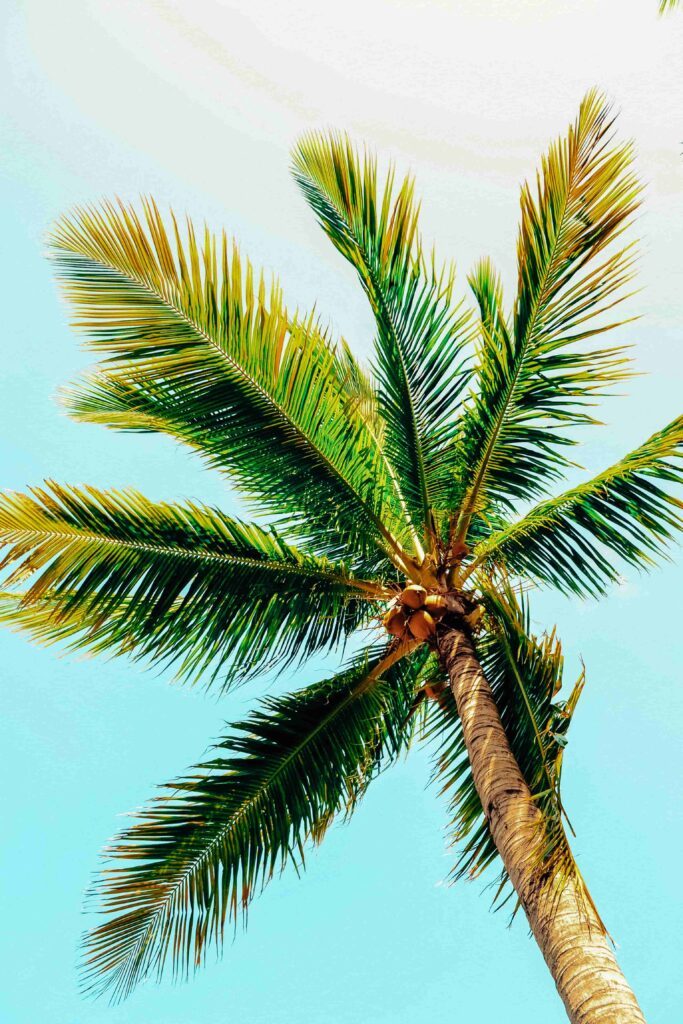
The Coconut Palm Tree is scientifically known as Cocos nucifera. It is an iconic and versatile tree that is widely recognized for its numerous uses and cultural significance. It possesses following characteristics and uses:
- Appearance: The Coconut Palm Tree can reach heights of 20 to 30 meters (66 to 98 feet). It features a single, straight, and smooth trunk, which is typically grayish-brown in color. The trunk is ringed with scars left by the fallen fronds. At the top of the trunk, a crown of large, feather-like leaves creates a distinctive and tropical appearance.
- Fruit Production: The most notable feature of the Coconut Palm Tree is its fruit—the coconut. Coconuts are large, round or oval drupes that measure approximately 20 to 30 centimeters (8 to 12 inches) in diameter. They have a fibrous husk that surrounds a hard, woody shell. Inside the shell, there is a layer of white, edible flesh known as the coconut meat, and a refreshing liquid called coconut water.
- Culinary and Nutritional Uses: Coconuts are highly valued for their culinary applications. The meat can be consumed raw or used in cooking, baking, or as an ingredient in desserts, curries, and savory dishes. Coconut have fats, vitamins, minerals, and dietary fiber in rich amount. Coconut water is a popular beverage, known for its hydrating properties and natural sweetness.
- Versatility: The Coconut Palm Tree is renowned for its versatility. Nearly every part of the tree can be utilized. The leaves can be woven to create thatch for roofs, mats, baskets, and other crafts. The trunk can be used for construction material or carved into decorative items. The husks of coconuts can be transformed into ropes, mats, and brushes. The fibrous inner layer of the husk, known as coir, is widely used for making ropes, mats, and natural fiber products. The coconut shells have various applications, such as bowls, utensils, and charcoal for fuel.
- Coastal Adaptation: Coconut Palm Trees are well-suited to coastal regions and thrive in sandy, well-drained soils. They are adapted to withstand strong winds and salty conditions, making them a common sight in tropical and subtropical coastal areas around the world.
- Propagation: Coconut Palm Trees are propagated through their large, round seeds—the coconuts. The seeds are dispersed by water or planted directly. It takes several years for a coconut palm to reach maturity and start bearing fruit.
- Economic Importance: The Coconut Palm Tree plays a significant role in the economies of many tropical regions. It provides livelihoods for communities involved in coconut cultivation, processing, and product manufacturing. The coconut industry encompasses various sectors, including agriculture, food production, cosmetics, and handicrafts.
- Cultural Significance: The Coconut Palm Tree holds cultural and religious importance in many tropical regions. It is often regarded as the “Tree of Life” due to its ability to provide food, shelter, and raw materials for daily life. Coconuts are used in religious rituals, celebrations, and traditional practices, representing fertility, abundance, and hospitality in many cultures.
The Coconut Palm Tree, with its striking appearance, versatile fruit, and cultural significance, continues to be an essential part of tropical landscapes and societies worldwide. Its multifaceted contributions to food, materials, and culture make it an invaluable resource and a symbol of the tropics.
3. Sago Palm Tree (Cycas revoluta)
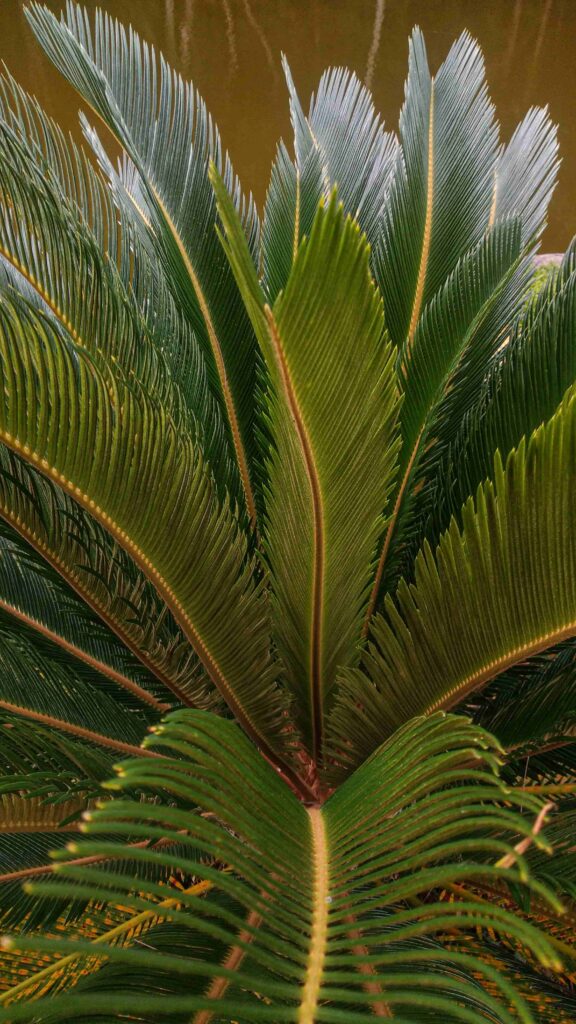
The Sago Palm Tree, scientifically known as Cycas revoluta, is an ancient and distinctive plant that resembles a palm tree but is not actually a true palm. It belongs to the cycad family and possesses several interesting features:
- Appearance: The Sago Palm Tree has a unique and striking appearance. It features a stout, cylindrical trunk with 2 to 3 meters (6.5 to 10 feet) height. The trunk is covered with rough, brown bark and often displays a slightly swollen base. At the top of the trunk, a dense crown of dark green, feathery leaves emerges, creating an attractive and tropical display.
- Foliage: The leaves of the Sago Palm are glossy, stiff, and pinnate, meaning they consist of numerous leaflets arranged along a central stem. The leaflets are lance-shaped and have a slightly revolute or rolled-under edge, giving the species its specific epithet “revoluta.” The foliage of the Sago Palm is evergreen and retains its lush appearance throughout the year.
- Growth Habit: The Sago Palm is a slow-growing plant that develops new fronds from the center of its crown. It produces a few leaves each year, gradually expanding its canopy. As the plant matures, it may develop multiple trunks or offsets at the base, creating a clumping effect.
- Reproduction: Sago Palms are dioecious, which means individual plants are either male or female. Male plants produce cone-like structures known as strobili, which contain pollen, while female plants produce larger, cone-shaped structures that bear seeds. The pollination process involves the dispersal of pollen by wind or insects to fertilize the female cones. The seeds, when mature, are orange or reddish in color and are contained within the female cones.
- Toxicity: It’s important to note that all parts of the Sago Palm, including the seeds, leaves, and bark, contain toxins called cycasin and cycad toxins. These substances can be harmful if ingested, particularly to pets and humans. Caution should be exercised when handling and growing Sago Palms, and they should be kept out of reach of children and animals.
- Landscape Use: The Sago Palm is a popular ornamental plant and is frequently utilized in landscaping projects. It is appreciated for its unique appearance, drought tolerance, and ability to thrive in various conditions. Sago Palms can be grown as specimen plants in gardens, used in container gardening, or employed in tropical-themed landscapes.
- Longevity: Sago Palms are known for their longevity and can live for several decades when provided with suitable growing conditions.
Despite its palm-like appearance, the Sago Palm Tree is a distinct member of the cycad family. Its striking foliage, slow growth, reproductive characteristics, and landscaping versatility contribute to its popularity as an ornamental plant. However, it’s essential to be aware of the plant’s toxic properties and take appropriate precautions when handling and growing Sago Palms.
4. Kentia Palm Tree (Howea forsteriana)
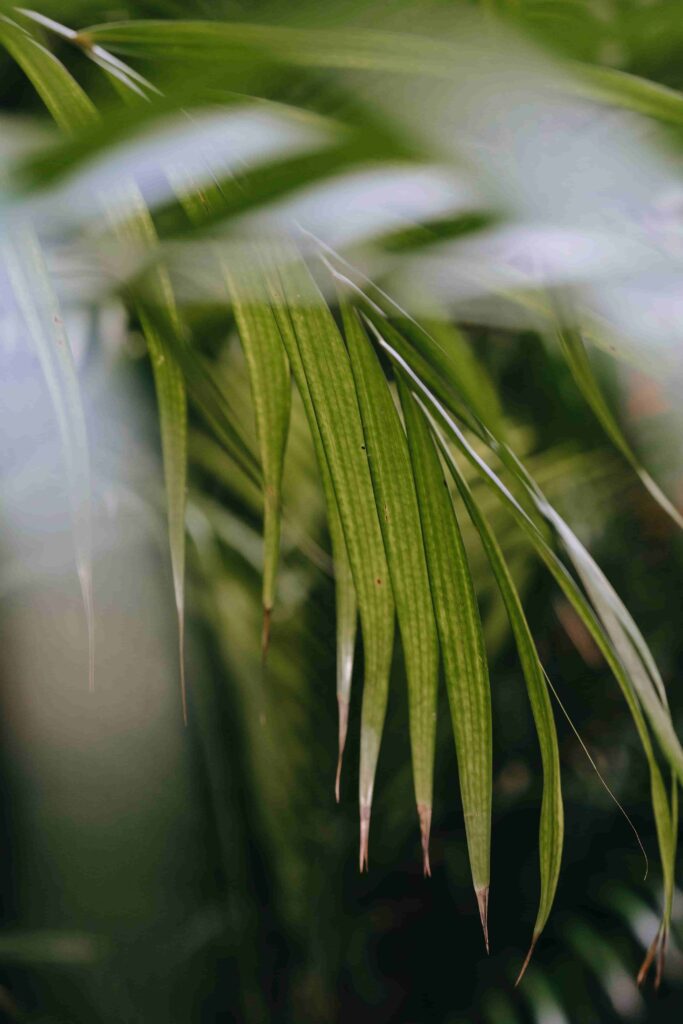
The Kentia Palm Tree, scientifically known as Howea forsteriana. It is a graceful and popular palm species with elegant appearance. It is capable of flourishing in both indoor and outdoor environments. These are some characteristics to explore:
- Appearance: The Kentia Palm is a relatively slow-growing palm tree with 6 to 12 meters (20 to 40 feet) height in its natural habitat. It features a slender, solitary trunk that is grayish-brown in color and has prominent ring-like patterns formed by the leaf scars. At the top of the trunk, a crown of arching, feather-like leaves emerges, creating a lush and tropical canopy.
- Foliage: The leaves of the Kentia Palm are long, pinnate, and glossy. They consist of numerous lance-shaped leaflets that are dark green in color. The leaflets are arranged along a central stem, giving the palm a feathery and graceful appearance. The foliage is known for its durability and ability to retain its attractive look even in low-light conditions.
- Indoor Adaptability: The Kentia Palm is highly valued as an indoor plant due to its tolerance for low light levels and its ability to purify the air. It can thrive in spaces with limited natural light, making it a popular choice for homes, offices, and other indoor environments. Its ability to remove certain toxins from the air makes it an excellent option for improving indoor air quality.
- Outdoor Use: While the Kentia Palm is often grown as an indoor plant, it can also be cultivated in outdoor settings. It is well-suited to tropical and subtropical climates and can thrive in areas with mild winters. In outdoor landscapes, it is commonly used as a decorative specimen plant, providing a touch of elegance and a tropical vibe to gardens, parks, and resorts.
- Maintenance: The Kentia Palm is relatively low-maintenance compared to some other palm species. It has moderate water requirements and prefers to be kept slightly moist but not waterlogged. It can tolerate occasional dry spells, but it is important to avoid overwatering. Regular dusting or wiping of the leaves helps to keep them clean and free from dust buildup.
- Propagation: Kentia Palms are primarily propagated from seeds. However, growing them from seeds can be a slow process, and it may take several years for the plants to reach a significant size. Therefore, many Kentia Palms available for purchase are typically propagated and grown by professional growers.s.
- Landscape Use: In outdoor landscapes, the Kentia Palm is often used as a focal point or as part of a tropical-themed garden. Its tall and slender silhouette, along with its attractive foliage, adds a touch of elegance and creates a sense of tranquility. It can also be planted in containers and placed on patios or by entrances to provide a dramatic and inviting look.
The Kentia Palm, with its graceful appearance, adaptability to indoor conditions, and landscape versatility, has become a beloved choice for interior decoration and tropical landscaping. Its ability to thrive in low light, purify the air, and add a touch of tropical ambiance makes it a popular selection for plant enthusiasts and designers alike.
5. Mexican Fan Palm Tree (Washingtonia robusta)
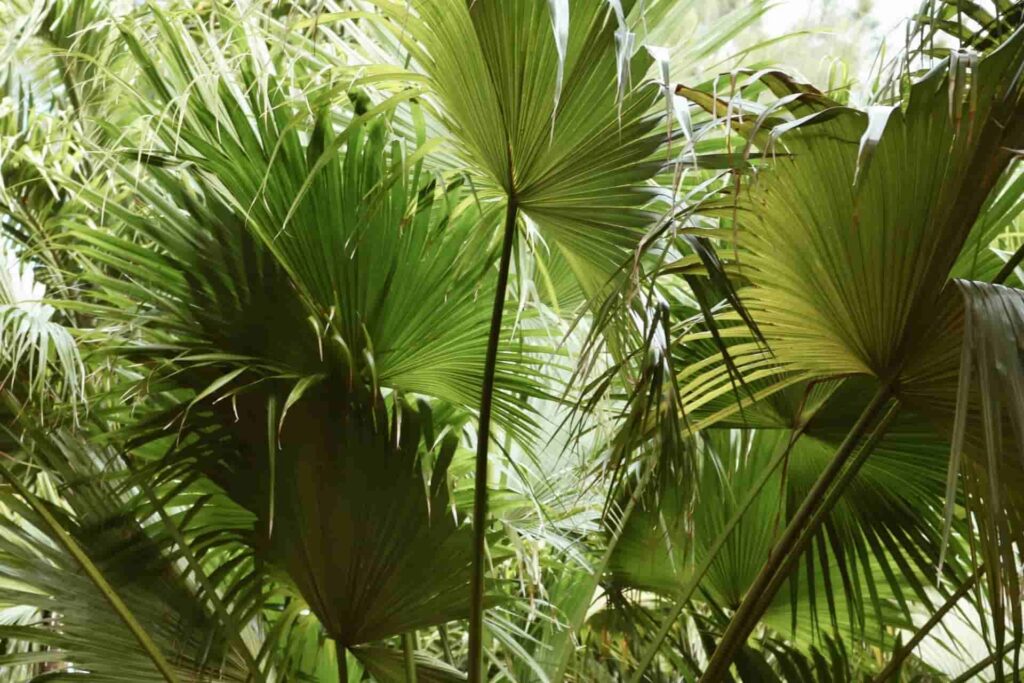
The Mexican Fan Palm Tree, scientifically known as Washingtonia robusta, is a tall and majestic palm species native to northwestern Mexico. It possesses several notable features that make it a popular choice for landscaping in various regions. These are some characteristics to explore:
- Appearance: The Mexican Fan Palm is a large palm tree 20 to 30 meters (66 to 98 feet)height. It features a straight, slender trunk with a smooth texture and a grayish-brown color. The trunk is adorned with prominent, vertical lines that are created by the leaf scars left behind as the fronds fall off. At the top of the trunk, a crown of large, fan-shaped leaves emerges, giving the tree its common name.
- Fan-Shaped Leaves: The leaves of the Mexican Fan Palm are divided into several segments that radiate from a central point, forming a fan shape. The leaf segments are long, narrow, and deeply divided, creating a feathery and ornamental appearance. The leaves are typically bright green in color and have a waxy texture.
- Rapid Growth: Mexican Fan Palm Trees can add several feet of height each year under favorable growing conditions, making them an excellent choice for those seeking a tall and quickly establishing palm tree.
- Drought Tolerance: Mexican Fan Palms are highly adaptable to arid and semi-arid environments. They are remarkably drought-tolerant and can withstand extended periods of dryness. This characteristic, combined with their ability to thrive in full sun, makes them a suitable choice for landscapes in regions with hot and dry climates.
- Landscape Use: The Mexican Fan Palm is widely utilized in landscaping projects, particularly in areas with a Mediterranean or desert-like climate. Its tall and slender form, along with its attractive fan-shaped leaves, adds a vertical and architectural element to gardens, parks, and urban landscapes. It is often planted in rows along streets or as a standalone specimen tree.
- Hardy Nature: Mexican Fan Palms are known for their resilience and ability to tolerate a range of soil conditions. They can adapt to various soil types, including sandy or clayey soils, as long as good drainage is provided. However, they prefer well-drained soils and may struggle in areas with excessive moisture or poor drainage.
- Propagation: The seeds of Mexican Fan Palm are typically spherical and small, and they can be collected and planted to grow new palm trees. However, it’s important to note that the seeds may take several months to germinate, and the resulting trees may exhibit variation in their characteristics.
The Mexican Fan Palm, with its tall stature, distinctive fan-shaped leaves, adaptability to arid climates, and rapid growth, is a favored choice for those seeking a visually striking palm tree. Its presence in landscapes brings a touch of elegance and a sense of the tropics, making it a popular selection for various outdoor spaces.
IV. Caring for Palm Trees
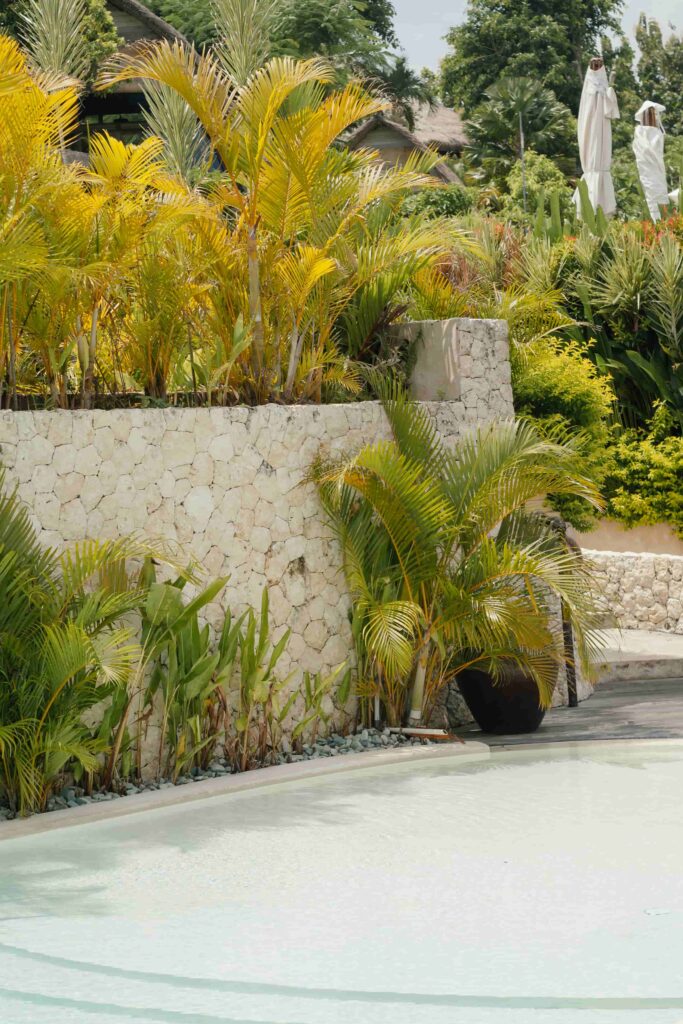
Palm trees are not only iconic and beautiful, but they also provide a sense of tropical paradise wherever they grow. Caring for palm trees is essential to ensure their health and vitality. Whether you have a few palms in your backyard or are responsible for maintaining a larger palm grove, proper care is crucial. This are the valuable tips on caring for palm trees and help them thrive.
A. Choose the Right Palm Tree
Before planting a palm tree, it’s important to choose the right species that is suitable for your climate and location. Different palm species have specific temperature and sunlight requirements. Research which species are suitable for your area and select a healthy specimen from a reputable nursery.
B. Soil Preparation and Planting the Palm Trees
Palm trees prefer well-draining soil, so it’s important to prepare the planting area accordingly. Ensure the soil is loose and amended with organic matter to improve drainage. Dig a hole large enough to accommodate the palm’s root ball and gently place the tree in the hole, making sure it is level and upright. Fill the hole with soil and water it thoroughly.
C. Watering the Palm Trees
Proper watering is crucial for palm trees, especially during their establishment phase. Young palm trees require regular watering to develop strong root systems. However, once established, most palm species are drought-tolerant and prefer infrequent but deep watering. Water the tree deeply, allowing the soil to dry out between watering sessions. It is important to refrain from excessive watering as it can result in root rot and other diseases.
D. Fertilization of the Palm Trees
Palm trees have specific nutrient requirements, and fertilization is essential to maintain their health and vigor. Use a balanced palm fertilizer with the right proportions of nitrogen, phosphorus, and potassium. Administer the fertilizer in accordance with the instructions provided on the packaging, typically during the period of active growth.. Avoid over-fertilizing, as it can cause nutrient imbalances and harm the tree.
E. Pruning and Trimming of the Palm Trees
Regular pruning and trimming help maintain the aesthetics and health of palm trees. Remove dead or dying fronds (leaves) by cutting them off at the base, being careful not to damage the trunk. It is advisable to refrain from excessive pruning as it can diminish the tree’s strength and increase its vulnerability to pests and diseases. Additionally, remove any browned or diseased flower stalks to prevent the spread of infections.
F. Pest and Disease Control in Palm Trees
Palm trees are susceptible to various pests and diseases, including aphids, scale insects, and fungal infections. Regularly inspect your palm trees for signs of infestation, such as yellowing leaves, white wax, or distorted growth. Use appropriate insecticides or consult with a professional arborist to treat pest problems. Implement preventive measures like regular fertilization, proper watering, and good sanitation practices to reduce the risk of diseases.
G. Protecting the Palm Trees from Extreme Weather
Extreme weather conditions, such as strong winds, frost, or excessive heat, can damage palm trees. When possible, protect your palm trees from such conditions by using windbreaks or shade cloth. During winter, consider wrapping the trunk with burlap or other insulating materials to prevent cold damage. Implementing a mulch layer around the tree’s base can serve as a means of insulation.
V. Conclusion
A. Recap of key points discussed in the guide
Caring for palm trees involves understanding their specific needs and providing them with the right conditions to thrive. By planting the right species, maintaining proper watering and fertilization, and addressing pest and disease issues promptly, you can enjoy healthy and vibrant palm trees in your landscape. Regular maintenance, such as pruning and protection from extreme weather, will help ensure the long-term health and beauty of these iconic trees.
B. Encouragement for beginners to explore and enjoy growing palm trees

Growing palm trees can be a fascinating and rewarding endeavor for beginners. By appreciating their beauty, researching the right variety, starting small, providing proper care, seeking knowledge from experts, embracing the learning process, and celebrating milestones, you can enjoy the journey of cultivating these magnificent trees. So, dive into the world of palm tree cultivation with enthusiasm, and let the joy of watching your palm trees grow become an enduring source of inspiration and fulfillment.
C. Final thoughts on the beauty and versatility of palm trees
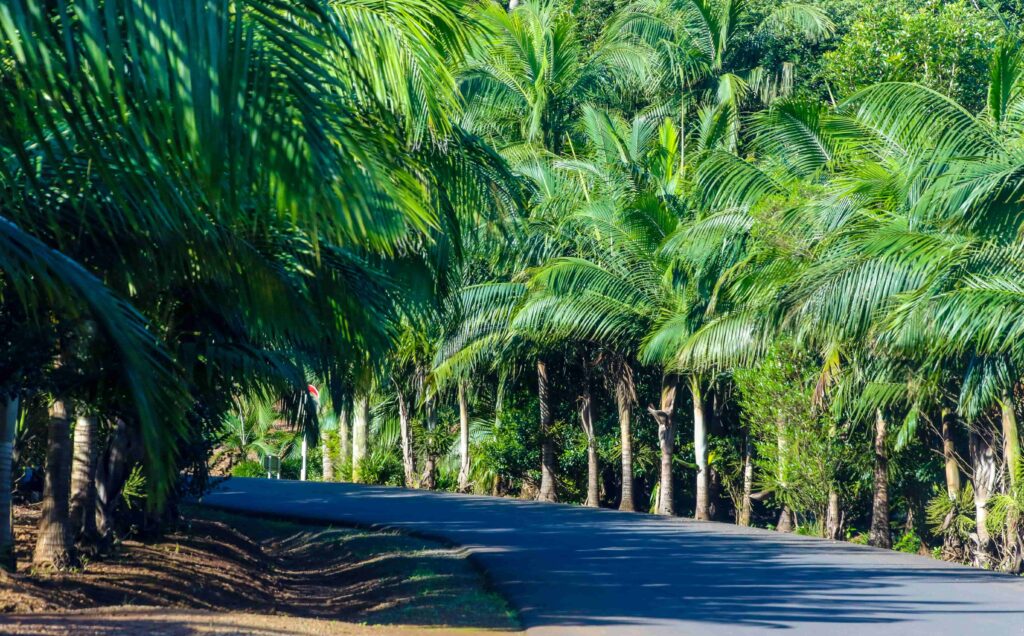
In conclusion, palm trees possess an enchanting beauty that enchants our senses and provides an array of practical benefits. Their aesthetic appeal, versatility, ecosystem support, economic significance, and cultural symbolism make them an integral part of our natural and cultural landscapes. As we admire these magnificent trees, let us appreciate their splendor and the valuable contributions they make to our world. Whether basking in their shade, marveling at their grandeur, or enjoying the fruits they bear, palm trees truly embody the spirit of beauty, resilience, and tropical enchantment.


3 thoughts on “Palm Trees: A Beginner’s Simple Guide to Caring Palm Species”